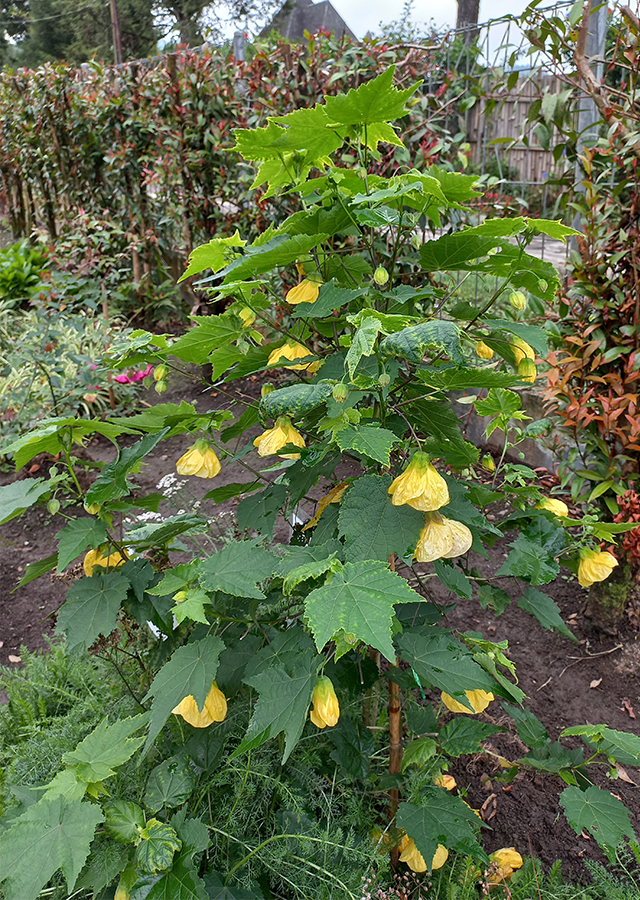Traditional Herbs from Abutilon indicum
toothache
- Take enough fresh afternoon flower leaves and wash them until clean.
- Boil the leaves\u00a0until they boil.
- Strain the boiled product.
- Use as a mouthwash to relieve toothache."], "cleaning_the wound
- Take enough afternoon flower leaves and wash them until clean.
- Boil until boiling.
- Let it warm then use it to clean the wound.
What is Abutilon indicum Looks like??



Parts of Abutilon indicum that could be used
- Leaves", "Seeds", "Bark", "Flowers", "Roots", "All Parts of the Plant
Abutilon indicum Distribution
Evening flower is a weed that is reported to originate from Africa, Asia and Australasia. This plant has flowers that open in the afternoon or evening, so this flower is known as 'Afternoon Flower'. This species has been widely used as a traditional medicinal plant in various countries. In India, evening flower is a source of medicine used in the Ayurvedic system of medicine to treat various diseases. Due to the importance of this plant in India as a medicinal plant, much research has been carried out to establish protocols for regenerating large quantities of callus culture derived from the leaves. In India, this plant is used as an aphrodisiac, and it is also reported to have been used by the Santals to treat various ailments including convulsions and cramps. In Indonesia, a decoction of the leaves is rubbed on the body to fight rheumatism. Meanwhile in Australia, afternoon flowers are used as food. The roasted seeds can be consumed as food. Apart from that, this plant has the potential to be used in phytoremediation of soil that can be contaminated with heavy metals, as well as as a botanical pesticide and a source of fiber (stems) for making burlap, paper and rope.
Agroecology of Abutilon indicum
Evening flowers can be found on roadsides, low bushes, savannas, lake shores, beaches, sand dunes and roadsides, from sea level to a height of around 1,600 m above sea level. This plant usually grows in tropical climates with warm temperatures. It likes sunny or half-day shade with fertile and well-drained soil, but is tolerant of drought conditions and saline environments.
Morphology of Abutilon indicum
- Stem erect, round, much branched, semi-woody, grey, velvety pubescent, often tinged with purple, base of stem woody.
- Leaves simple, green, ovate-orbicular, base heart-shaped , irregular serrated edges, pointed or pointed leaf tips, alternately located, both sides are soft, velvety-pubescent. Petiole 2-4 cm, stipules subulate (needle-shaped) and curved outwards.
- Flowers solitary, axillary (located in the leaf axils). Petals are green, disc-shaped, short and smooth gray hairs, 5 lobes, petals broadly ovate, pointed tip. The corolla is 5 in number, measuring 7-8 mm, triangular-ovate, staminal tube with long, stiff hairs (hirsute) with star hairs. Flowers open in the afternoon or evening.
- The fruit is shaped like a pressed ball, green in color , circular, flat top, pointed tip, slightly sinuous, with 11-20 radiating carpels, each carpel flat, somewhat shaped like a boat. The fruit is hispid, long stellate.
- Seeds reniform, rarely stellate, pubescent, dark brown or black.
Cultivation of Abutilon indicum
- Propagation is carried out generatively (seeds) or vegetatively (stem cuttings, shoot cuttings).
- Flowing depends on temperature and light, flowering occurs at a temperature of 25-30\u00b0C, on cloudy days the flowers open at 16.00 or at night." ]
Abutilon indicum, more details :
Chemical Content of Abutilon indicum
Steroids, sapogenins, saponins, alkaloids, phenols, coumarins, flavonoids, tannins, asparagine, abutilin A, (R)-N-(1'-methoxycarbonyl-2'-phenylethyl)-4-hydroxybenzamide, essential oils (alpha-pinene, caryophyllene oxide, endesmol, farnesol, borenol, geraniol, geranyl acetate, elemente, alpha-cineole), eudesmic acid, ferulic acid, caffeic acid, 2-pentanone,4-hydroxy-4- methyl, 2-Hexanol,2-methyl, 2-pentanol,2,3-dimethyl, m-xylene, p- xylene, o-xylene, c-sitosterol, a-sitosterol, cholest-5-en-3-ol, 4,4-dimethyl-,(3a)-, lupeol, lup-20(29)-en-3-ol,acetate,(3a)-, 9,19-cyclo-9a-lanostane-3a,25-diol, taraxerol, 4 hydroxyphenylacetic acid methyl ester, 5-thio- D-glucose, 5-allylsulfanyl-1-(4-methoxy-phenyl)-1H-tetrazole, E)-10-Heptadecen-8-ynoicacid methyl ester, and Z-11-hexadecenoic acid.
Benefits of Abutilon indicum
Treating and cleaning wounds, convulsions, cramps, colic pain, spermatorrhoea (uncontrolled ejaculation), dysmenorrhea (painful menstruation), menorrhagia (excessive menstruation), dysentery and stomach ache, reduce fever, relieve inflammation of abscesses, boils, inflammation gums, toothache, tuberculosis, cough, bronchitis, earache, tinnitus (ringing in the ears), body ache, hemorrhoids, dysuria (pain when urinating), increased urination urine, treats urethritis (inflammation of the urethra), diabetes, skin ulcers, leprosy, helps blood clot, sedative, is an aphrodisiac, laxative, astringent, immunomodulator, analgesic, antimalarial, antimicrobial.
Simplisia of Abutilon indicum
Another Facts for Abutilon indicum :
Synonym of Abutilon indicum
Abutilon albidum (Willd.) Sweet, Abutilon album Hill, Sida asiatica L.
Habitus of Abutilon indicum
Bush. Annual shrub, up to 2.5 m high
Habitat of Abutilon indicum
- Riverside", "Coast", "Roadside", "Bush Area", "Grassland", "Land



No comments:
Post a Comment